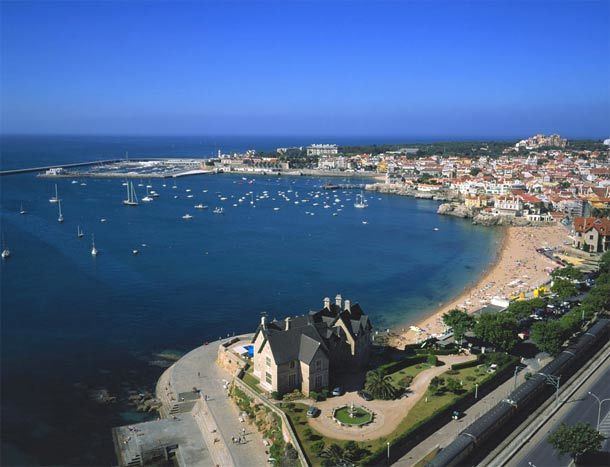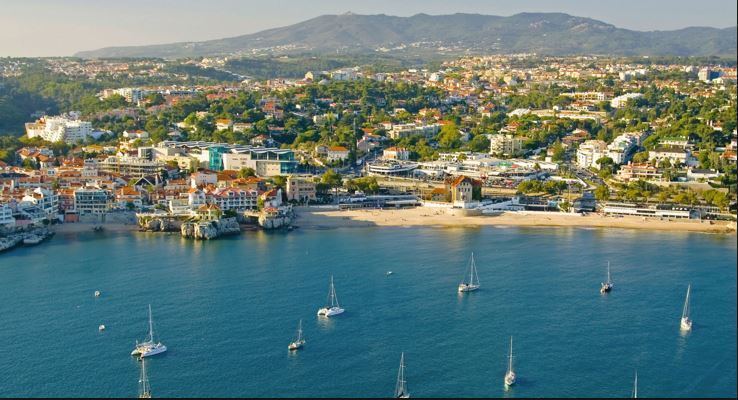 | ||
The Portuguese Riviera (Portuguese: Riviera Portuguesa) is the coastal region to the west of Lisbon, Portugal, centered on the towns of Cascais, Estoril, and Sintra. It is coterminous with the Estoril Coast (Costa do Estoril) and occasionally known as the Costa do Sol (Sunny Coast). The region is known as a popular luxury resort area and for its history as a home of the wealthy and famous.
Contents
- Portuguese riviera estoril coast with beautiful beach part 4
- Origins
- 19th century
- World War II
- Today
- Climate
- Places
- Music
- Film
- Sporting
- Royalty and nobility
- Celebrities
- Politicians
- References

Both Cascais and Sintra consistently rank among the richest municipalities in Portugal and among the richest in the Iberian Peninsula. Because of its numerous resorts, estates, luxury shopping, and coastal nature, the area has been likened to the French and Italian Rivieras, from which it derives its name.

Cascais's history as a cosmopolitan center originates in the 1870s, when King Luís I of Portugal and the Portuguese royal family made the seaside town his summer residence, thus attracting members of Portugal's aristocracy, who established a summer community there. During World War II, the area's royal affiliations intensified, as many heads of European royal houses and deposed monarchs, such as Edward VIII of the United Kingdom (at that time, Duke of Windsor) and Juan Carlos I of Spain (at the time, Infante of Spain) made their home in Cascais and Estoril, finding refuge in Portugal's neutrality in the war or from tense political situations in their own countries.

Sintra had been a royal retreat since the 15th century, but it was in the 19th century when it became the center of the Romanticist movement in Portugal that it became a summer residence of the Portuguese nobility. Sintra's belle epoch during this time resulted in the numerous villas, gardens, estates, and palaces that characterize the area.

Portuguese riviera estoril coast with beautiful beach part 4
Origins

During the third quarter of the 18th century and practically all of the 19th century, foreign travelers and Portuguese aristocrats, fired by Romanticism, rediscovered the magic of Sintra, especially in its exotic landscapes and climate. In the summer of 1787, William Beckford stayed with the Marquis of Marialva, master of the horse for the kingdom, at his residence of Seteais Palace. At the beginning of the 19th century Princess Carlota Joaquina, wife of the Regent John, bought the estate and Ramalhão Palace. Between 1791 and 1793, Gerard Devisme constructed a Neo-Gothic mansion on his extensive estate in the Quinta de Monserrate (later known as the Monserrate Palace). Beckford, who remained in Sintra, rented the property from Devisme in 1794. The landscape, covered in fog, also attracted another Englishman, Francis Cook, who occupied the estate, constructing an oriental pavilion. The Palace of Pena, Sintra's exemplary Portuguese Romantic symbol, was initiated by the King-Consort Ferdinand, husband of Queen Maria II of Portugal.
19th century
In 1854, the first contract was signed to construct a rail link between Sintra and Lisbon. A decree signed on 26 June 1855 regulated the contract between the government and Count Claranges Lucotte but was later rescinded in 1861. The connection was finally inaugurated on 2 April 1887.
The origin of the Portuguese Riviera as included Cascais and Estoril originated when King Luís I of Portugal ordered a royal residence to be constructed in Cascais Citadel, starting the tradition of Cascais being the Portuguese royal family's summer residence, which lasted from 1870 to 1908. The royal family repaired to Cascais to enjoy the sea, turning the tiny fishing village into a cosmopolitan address. Thanks to King Luís I, the citadel was equipped with the country's first electric lights in 1878.
Cascais also benefited with the construction of better roads to Lisbon and Sintra, a casino, a bullfight ring, a sports club, and improvements to basic infrastructure for the population. Many noble families built impressive mansions still to be seen in the town centre and environs. The first railway arrived in 1889.
In 1896, King Carlos I of Portugal, a lover of all maritime activities, installed in Cascais Citadel the first oceanographic laboratory in Portugal. The King himself led a total of 12 scientific expeditions to the coast; these ended in 1908 with his assassination in Lisbon.
From the second half of the 19th century into the first decades of the 20th century, Sintra also became a privileged place for artists: musicians such as José Vianna da Motta; composers such as Alfredo Keil, painters like João Cristino da Silva (author of one of the most celebrated canvases of Portuguese Romantic art, "Cinco Artistas em Sintra"), writers such as Eça de Queirós or Ramalho Ortigão, all these people lived, worked or got inspiration from Sintra's landscapes.
By the beginning of the 20th century, Sintra was recognized as a summer resort visited by aristocrats and millionaires. Among these, Carvalho Monteiro, owner of a considerable fortune (known as "Monteiro dos Milhões") constructed near the main town on an estate he bought from the Baroness of Regaleira, the Quinta da Regaleira, regarded as a prime example of Neo-Manueline architecture.
World War II
During the Second World War, the region was the centre of spies and diplomatic secrecy, situations that provided the region with a cosmopolitan atmosphere and sophistication. Due to the vision of Fausto Cardoso de Figueiredo and his business partner Augusto Carreira de Sousa, it became an international tourist destination both during and after the Second World War.
In July 1940, Edward, Duke of Windsor (former Edward VIII of the United Kingdom) and his wife, Wallis Simpson, moved to Estoril, where they lived at first in the home of Ricardo de Espírito Santo, a Portuguese banker with both British and German contacts.
During that time, several dignitaries and exiles came to Estoril: Miklós Horthy, the regent of the Kingdom of Hungary (lived and died in exile after the Second World War); the Infante Juan, Count of Barcelona (father of Juan Carlos I of Spain) and the King resided in the territory, as did Umberto II of Italy and Carol II of Romania.
It was also in this location that former Portuguese dictator António de Oliveira Salazar had a summer house. It was Salazar who ordered the construction of the E.N.6 motorway, more commonly referred to as the Avenida Marginal, in order for him to quickly travel by car between Cascais and Lisbon (until then the accessway was nothing more than a dirt road, where traffic could only circulate at low velocities and make frequent stops). The roadway permitted the dictator to travel rapidly, and with fewer stops, it wasn't possible for him to be recognized easily in transit.
Complimenting the jet-set community that prospered in the region, Casino Estoril, Europe's largest casino, was founded in 1958.
Today
Today the towns of the Portuguese Riviera continue to play residence to the Portuguese elite and vacation to international travelers. The Riviera plays an important part of tourism in Portugal, with millions coming to see the area's palaces, beaches, restaurants, and museums.
A large expatriate community continues to exist in Cascais of people from around the world, leading to the majority of Lisbon's international schools being located within the area (with Carlucci American International School in Sintra, St Julian's School and St Dominic's School in Cascais, and Oeiras International School).
Since the middle of the 20th century, the region has come to play host to numerous international sports and entertainment festivals, such as the Lisbon & Estoril Film Festival (in Estoril), the 4 Hours of Estoril endurance race (in Cascais), and NOS Alive music festival (in Algés).
Climate
The region has a Mediterranean climate, influenced by the Atlantic and characterized by moderate temperatures and wet winters. Although the climate in the area of Cabo da Roca is semi-arid, the Sintra Mountains are considered moderately humid: precipitation in the mountains is higher than in the surrounding areas.
Places
Places following the broadest definition of the Portuguese Riviera:
